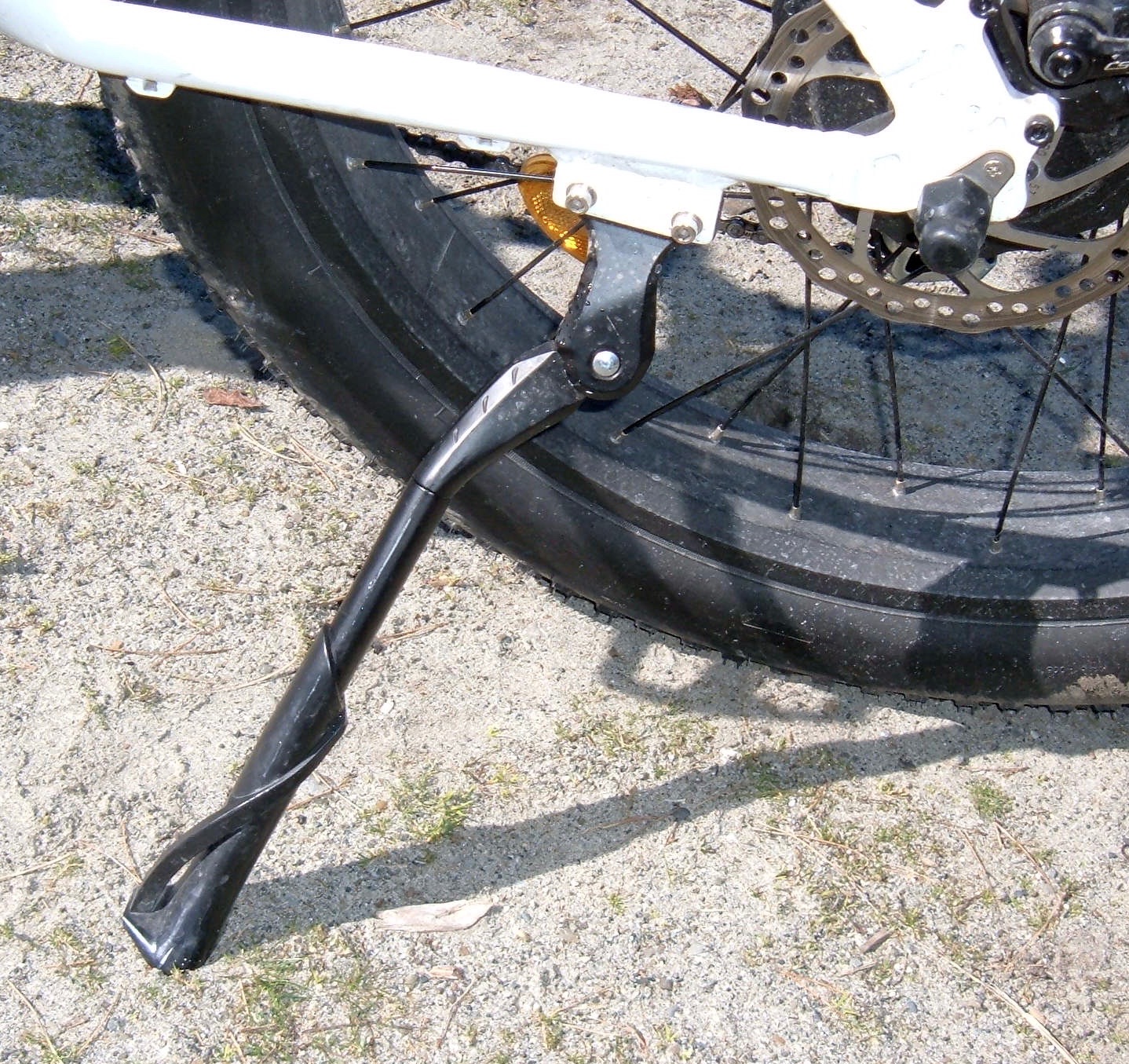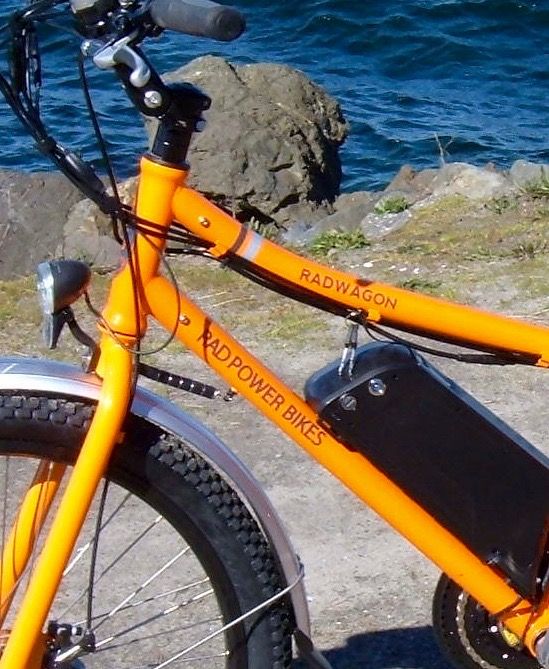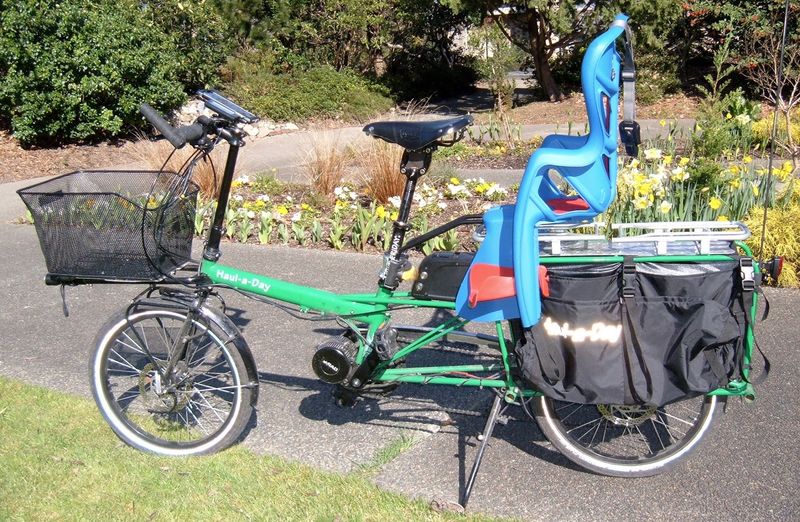On a beautiful Thursday a few weeks ago, I test rode both of Rad Power’s 2016 models.
The Rad Wagon is a truly excellent all around electric long tail cargo bike - if you didn’t catch my review of it, you should read it, because there are a lot of common features on these two bikes, and I’ll refer back to that review a good bit here.
The Rad Rover, on the other hand, is more designed for pure fun. And, I think it’s misnamed.
It should be called the “Rad FacePain,” or perhaps the “Rad Grin Maker.” Because if your face doesn’t hurt from grinning after riding this, you might just be dead.
This is a $1500 factory built bike. It performs like a $1500 DIY build. That’s impressive.

Read on, because you know you want to.
The Rad Rover

The 2016 Rad Rover is an electric fatbike. That means it has a motor (not that you can tell without looking closely - the battery stands out far more than the motor), and it has huge 4” tires that will go over just about anything out there.

Unlike the Rad Wagon’s direct drive motor, the Rad Rover comes with a geared hub motor. This type of motor uses internal reduction gears to allow a small motor to spin faster, then down that speed into more torque.
Torque is fun. Generally speaking, more torque is more fun. And this bike has gobs of it!
Before I get into how it rides, I’m going to cover some of it’s features. Quite a few are shared with the Rad Wagon - the bikes use many identical parts. Some, however, are unique to the Rad Rover.
Features
Shifter (singular)
The shifter is the same unit used on the Rad Wagon. Press the big lever to shift down, press the “+” button to shift up. It’s a bit different from other bikes, but it works just fine.
Since there’s no front derailer, there’s just one control for the rear.

Kickstand
The Rad Wagon uses a rear mounted kickstand instead of the more traditional center mounted kickstand. The mounts for it are built onto the frame, and the advantage seems to be that it’s easier to get it out further away from the bike - which improves stability of the 60lb monster when you’re not on it.
I’ve owned a few bikes with the kickstands back there, and the only real downside is that you have to dismount to drop the kickstand. You can’t just kick it down from the seat. However, a dedicated mount means it’s not squeezing the tubes like a normal kickstand - and it’s less likely to come loose when going down something that resembles the moon more than a road. I think it’s a great option for something you’re planning to take to inappropriate places.
Light
The Rad Rover comes with a front mounted LED light. Unlike the Wagon, there’s no rear light - so if you ride at night, you’ll need to toss a light on the seat post. Since there’s no cargo tail, there won’t be anything blocking it, and you can find some wonderfully cheap bike lights. Since it was an insanely sunny and beautiful day, I have no idea how well this lights the road at night, but if you’re riding at night a lot, more lights are always better.

Brake Mounted Bell
I cannot tell you how much I hate coming up on people with headphones in on trails. They don’t hear a bike, and they won’t hear you asking them to move over.
The Rad Rover comes with a perfect solution to this problem! The brake lever has a little bell built in!
Tugging the lever is rewarded with a very sharp, high pitched *ping* from the bell. It’s exactly the sort of abrupt, piercing sound that will punch through most headphones and convince people that there’s something behind them and, perhaps, they should move over.
The lever has a nice quick reset, so it’s easy to launch a string of pings at people who remain particularly clueless about the bike closing in on them.

Handlebar Grips
I’m not sure what, exactly, they’re made of. But I do know they’re beautiful, and they’re most unusual.
The grips are sewn together with a thick thread, in a very distinctive pattern.
I can’t say I noticed a difference when I was riding, but they do look amazing, and they stand out as something very unique!
And, they match the seat!


Seat
The seat is the same unit used on the Rad Wagon, in a different color.
It’s a fairly comfortable unit, but as I ride a lot, I prefer narrower, harder seats. This is a decent compromise for people who don’t ride as much, and the fabric is quite slick so it rides OK, but if you’re doing a lot of riding, you may want to get something different.
I wouldn’t replace it until it bothers you, though.

Derailer Guard
Nothing says, “We expect you to take this bike utterly inappropriate places” like a derailer guard.
Bolted to the frame is a large, thick hunk of formed metal. It serves very nicely to keep the derailer protected from most varieties of tipping the bike over. I’ve never actually seen one of these before, but it seems like a good idea to me!


Chain Keeper-Onner
A problem with single front chainrings can be the chain jumping off if it gets slack. With a front derailer, the chain director keeps the chain in line - but without this, there’s nothing to keep the chain lined up with the chainring.
As you can see below, keeping the chain on is not a problem on the Rad Rover. It’s got plastic shrouds on both sides that keep the chain well seated on the chainring, and even if there’s a bit of slack, it’s not going to jump off.
I’m sure there’s a better name for this part the a Chain Keeper-Onner. But I have no idea what it is!

Riding
If this bike doesn’t put a big, stupid ebike grin on your face, there’s a good chance your facial muscles simply don’t work. This bike has gobs of torque, huge tires to soak up all the punishment, and just goes over everything.

I took the same 5 mile route I tested the Rad Wagon on. It involves bike trails, a steep hill climb, residential roads, and a few detours into inappropriate places for street bikes.

I climbed 295’ from barely above sea level to just over 300 feet, and came back down. Then went back up. And down again. And maybe did that another time or two. Because I could, and because it was fun!

At first glance, the rear Bafang motor looks tiny, and some might wonder how a motor that small can be any good. It blends smoothly into the brake rotor and gears, and looks more like an internally geared hub than a motor. Worry not! It’s very wide (the bike has a wider-than-usual dropout width to fit it), and is a geared motor, which means the motor can turn quickly and use a set of reduction gears to turn the rapidly spinning bits into gobs of torque.

Going down the road, the first thing you’ll notice is the noise. This is a loud bike - and it’s not the motor. The huge tires have a decent set of knobs on them, and they make quite the racket on the road. I’d say it’s loud enough to let people know you’re coming without having to use the bell, but, sadly, it’s not. Happily, the bell is excellent.
I’d not ridden a fatbike before this. I thought they were a little bit silly. I still think they’re a little bit absurd, but absurd in much the same way that a Lamborghini or Ferrari is absurd. They’re just entirely overkill for roads - but they make such an amazingly smooth ride on nearly anything!
This thing just chews up anything faintly road-like. It doesn’t even have to be very flat. Roads? Beat up roads? Trails? Paths? Gravel? Beat to death roads climbing up a steep hill? It just doesn’t matter. The bike loves it, and gives you a grippy, cloud-like ride over absolutely everything.

An interesting quirk of having fatbike tires and front suspension is that the thing seems to be a pothole magnet. Normally, cruising along at 20mph, I try to avoid potholes, speedbumps, manhole covers, and the like. With this bike, I found myself actively seeking them out, just to see what it could handle. And it swallowed everything I tossed it at with far more grace than a mildly absurd electric fatbike ought. If you’re concerned about a cratered road, don’t be. This bike will just devour it. Between the 4” tires and the front suspension, I couldn’t find anything that disrupted it’s progress.

Without Power
In contrast to the Rad Wagon, this bike only has one front chainring and 7 sprockets in the rear. It’s a great set of ratios for when the motor is running, but it’s not very good without the motor. You can putter along without power on the flats, but you’re not going to climb many hills without the motor. Budget power accordingly!
With Power
This is how you want to ride the bike. There’s a 750W torque monster buried in the rear wheel, and it turns the bike from a heavy bike with huge, soft tires into an absolute rocket that will climb anything and go through anything.
The pedal assist system works great. It doesn’t try to be fancy - it just functions as a switch to turn on the motor based on the currently selected assist level. Changing assist levels changes the maximum power output and the maximum speed the motor will assist to. Turn it up and go!
If that’s not your style, the throttle works too. It’s a half twist throttle with a toggle button below it. Twist to go. Twist more, go more. Simple!
Normally, geared motors have a bit of a whine to them. This one probably does as well, but you cannot hear it over the tire noise.
With the motor running, this bike goes. It doesn’t ride like a 60 pound fatbike. It rides like a small motorcycle. The motor scoots the bike right up to 20mph, and holds it there nicely, should you care to cruise at this speed.
The bike seriously goes over anything. I went about trying to find the worst potholes, craters, and terrain I could - and nothing bothered it. You simply should not aim for potholes at 20mph - but this bike doesn’t care! It loves it, and encourages it!
Wet. Mud. No Fenders.
I’ve been riding bikes with good fenders for a very long time. So much so, that I entirely forgot this bike has none until I went through the first water-filled pothole at 20mph, and felt a solid spray hit my back.
Without fenders, this is a dry weather bike only. If you ride in the rain, on wet roads, or in anything resembling mud, it will liberally coat you in whatever it picks up from the road. The front tire will hose your front down, and the rear tire will get your rear. Showering in road water isn’t very fun.
If it’s dry? Don’t worry about it. Just try to avoid puddles.
If you’re in, say, Seattle? Find fenders unless you just want to ride in the summer.

Hills
A glance at the GPS route and terrain data indicated that I went up some hills. Visual inspection of the terrain also indicated some angle changes that appeared to be “hills.” Riding the bike? I sure couldn’t tell.
The bike slows down a slight amount going up hills, and you might want to drop a gear or two. With the pedal assist turned up, or the throttle wide open, that’s about it. It loves climbing. You can climb anything you want on this bike.
Brakes
Like the Rad Wagon, the Rad Rover uses cable actuated disc brakes. They’re not amazing, but they do get the job done. The brake feel is a bit heavy, but they’ll stop the bike in a hurry.
This is one of the things that helps get the cost down. A nice set of hydraulic brakes would add a good bit to the cost of the bike, feel better, but not really stop any better.
Battery, Console, Pedal Assist, and Throttle
The battery that comes with the Rad Rover is a 48v, 11.6Ah battery - over 550Wh of capacity. That’s huge.
Typically, an electric bike on the throttle will consume 30-35Wh/mi. With a 550Wh pack, 35Wh/mi gets you 15.7 miles - on the throttle, without much pedaling.
With a good pedal assist system, you’ll use closer to 15Wh/mi - so ~37 miles.
If you use the motor less, you’ll obviously get less range.
Rad Power claims a 15-50 mile range for this bike - which is entirely reasonable! I expect most people will find it closer to the 15 than the 50, simply because it’s so much fun under power!
The battery pack a fairly standard case, and comes with charge lights on it, as well as a USB power port for charging phones or GPS units or anything along those lines.
Conveniently, this is a pretty standard battery unit. If Rad Power decides to build larger units in the future, they can swap right in, and even if they don’t, you should be able to find compatible batteries for this bike well into the future.

The console is the exact same unit that’s on the Rad Wagon. It shows the battery status, total mileage, current speed, current pedal assist level, watts, and a few other things. The LCD panel is perfectly readable in bright sun, and is backlit for night use.

The power control of this bike is also exactly the same as the Rad Wagon.
Down by the crank, a set of magnets and a sensor detects pedal rotation. This is fed as a “pedaling/not pedaling” signal to the controller, which will apply power to the motor when pedaling, with the power and the maximum speed set by the level selected with the arrows on the left bar.
If you want more power than the current pedal assist level, the twist throttle on the right bar will add more power in, returning to the set level if you let go.
Turning the pedal assist to level 0 means it’s a pure throttle bike, and clicking the red “lockout” button on the throttle will disable the throttle and make it pure pedal assist.
It’s a simple system, but it works remarkably well - partly because it doesn’t try to be too smart. Instead of trying to determine something by speed, the “on/off” nature of the pedal sensor makes it easy to understand what the bike will do. You can pedal along, you can “spin” the pedals in a low gear to make the motor kick in, or you can use the throttle.
A single connector runs to the rear for the motor power and sensor lines - so there’s not much extra to disconnect if you need to remove the wheel for maintenance.

Controller
While I was at the store, I got to see a disassembled controller. And I am impressed! This is the same controller as the Rad Wagon, just programmed slightly differently.
It’s a fully potted 12 FET controller, contained in a strong aluminum enclosure that’s sealed with an o-ring. You can see the potting below - it’s the “goop” covering everything. It waterproofs the controller, helps with heat transfer away from components, and keeps things from moving or rattling around (while still allowing enough flex for thermal expansion).

The chassis of the controller has a large aluminum fin that cools the switching transistors - they dump their heat into this, and then transfer that heat into the base and the cover.

The bottom of the controller casing also has fins for heat dissipation, and is screwed into the bike chassis - which also acts as a heatsink. The cover is a thick aluminum piece as well.

This controller is absolutely overkill for the bike. Most 12 FET controllers on the market are rated for 35A or 40A. On this bike, with a 48v battery, the maximum current it will see at 750W is about 16A. That’s less than half of what someone else might rate a similar controller.
Why do this? Reliability. Running a controller up near rated capacity works - at least for a while, until it doesn’t.
Running this controller at a maximum of 50% of what it can handle, then putting it in a well cooled and waterproof enclosure, means it should last pretty much forever. Even if it’s being ridden daily up hills, this controller has so much spare capacity, and so much cooling, that it’s simply not being worked hard at all.
I can’t ask for anything more. The team building this bike has done an amazing job of spending money where it matters - and this controller should be bulletproof.
Tweaks I’d Make
This bike is a bit further from something I’d really ride on a regular basis, but even so, I could replace my commuter with it. I’d change the following:
- Add a mirror. Again, mirrors are incredibly helpful for riding on city streets, and I feel utterly blind without them.
- Add a tail light. It doesn’t come with one. Fortunately, there are a wide variety of cheap bike lights on eBay, and most of them are decent enough.
- Install good, wrap around fenders. I just can’t get excited about my back being coated in water, road grit, and mud. And I don’t often take bikes places where this would be a problem, clearance-wise.
Conclusions
The Rad Rover is an insane amount of fun to ride. It has tons of power, gobs of torque, a huge battery, and goes up and over pretty much anything you’re likely to encounter.
I’m very impressed with the capabilities of a fatbike. The suspension and the tires just soak up everything the worst roads I could find offer - and I tried to find the worst!
In terms of power and range, it’s absolutely the equal to my daily driver commuter build - if anything, it has more torque than my commuter. I think it climbs hills better.
But, despite that, it’s not something I’d really want to own. It’s insanely fun to ride, and I’d certainly borrow one for a day at a time, but I don’t think I’d want it in my stable, simply because I wouldn’t ride it enough.
At least in Seattle, the lack of fenders is a killer. I ride year round, which means 75% of the time, the roads are wet. Most fatbike fenders are mountain bike style fenders - so they stick out and block some of the spray, but they don’t block nearly as much spray as a good set of wrap around fenders (which are remarkably hard to find for fatbike sizes, and are rather expensive if you do find them).
I’m moving somewhere drier, where this might be more fun, but I like my bikes to be practical as well as fun, and for the extra $100, the Rad Wagon is radically more capable for the types of trips most people make, comes with fenders, and is nearly as much fun to ride!
Should you buy this bike?
That really depends on what you’re looking for.
If you’re looking for a daily driver type bike, and you live somewhere with reasonable roads, get the Rad Wagon. It’s a more capable bike for the type of things one wants in a commuter/grocery getter. It’s slightly less exciting, but it’s really, really good at replacing a car.
On the other hand, if you want something to handle steep hills, torn up roads, questionable trails, the potholes of city life, and you’re willing to either get wet, ride in the dry, or find fenders? Absolutely, buy it! It’s an amazing amount of fun.
The Value of Rad Power Bikes
The reality is, both the Rad Rover and the Rad Wagon are excellent bikes. They’re designed for different purposes, but they’re both damned good.
What’s even more impressive is that they’re damned good commercial bikes - at a DIY cost!
You’d be hard pressed to build a bike comparable to either the Rad Wagon or the Rad Rover from parts, and come in enough cheaper to matter. Throw in the amazing designs and the warranty (1 year on both) - and there’s just no point to building it yourself anymore!
If you do happen to pick one up, feel free to list me as a referrer - just list “Russell Graves/Syonyk” as the referrer. I have no idea what will happen since I don’t (yet) own one, but if you don’t have anyone else to list, go ahead & let them know I sent you!
I am absolutely blown away by what Rad Power has accomplished. The value of both of these bikes is insane - not just because they’re DIY-priced, but because they’re both excellent bikes!
Comments
Comments are handled on my Discourse forum - you'll need to create an account there to post comments.If you've found this post useful, insightful, or informative, why not support me on Ko-fi? And if you'd like to be notified of new posts (I post every two weeks), you can follow my blog via email! Of course, if you like RSS, I support that too.









